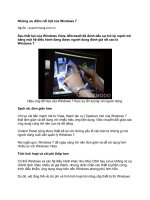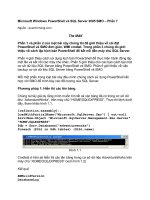Pro Windows Embedded Compact 7 pptx
Bạn đang xem bản rút gọn của tài liệu. Xem và tải ngay bản đầy đủ của tài liệu tại đây (10.2 MB, 279 trang )
www.it-ebooks.info
Pro Windows Embedded
Compact 7
Producing Device Drivers
■ ■ ■
Abraham Kcholi
www.it-ebooks.info
Pro Windows Embedded Compact 7
Copyright © 2011 by Abraham Kcholi
All rights reserved. No part of this work may be reproduced or transmitted in any form or by any means,
electronic or mechanical, including photocopying, recording, or by any information storage or retrieval
system, without the prior written permission of the copyright owner and the publisher.
ISBN-13 (pbk): 978-1-4302-4179-9
ISBN-13 (electronic): 978-1-4302-4180-5
Trademarked names, logos, and images may appear in this book. Rather than use a trademark symbol
with every occurrence of a trademarked name, logo, or image we use the names, logos, and images only
in an editorial fashion and to the benefit of the trademark owner, with no intention of infringement of
the trademark.
The use in this publication of trade names, trademarks, service marks, and similar terms, even if they are
not identified as such, is not to be taken as an expression of opinion as to whether or not they are subject
to proprietary rights.
President and Publisher: Paul Manning
Lead Editor: Ewan Buckingham
Technical Reviewer: Valter Minute
Editorial Board: Steve Anglin, Mark Beckner, Ewan Buckingham, Gary Cornell, Morgan Ertel,
Jonathan Gennick, Jonathan Hassell, Robert Hutchinson, Michelle Lowman, James Markham,
Matthew Moodie, Jeff Olson, Jeffrey Pepper, Douglas Pundick, Ben Renow-Clarke,
Dominic Shakeshaft, Gwenan Spearing, Matt Wade, Tom Welsh
Coordinating Editor: Jessica Belanger
Copy Editor: Lori Cavanaugh
Production Support: Patrick Cunningham
Artist: SPi Global
Indexer: BIM Indexing & Proofreading Services
Cover Designer: Anna Ishchenko
Distributed to the book trade worldwide by Springer Science+Business Media, LLC., 233 Spring Street,
6th Floor, New York, NY 10013. Phone 1-800-SPRINGER, fax (201) 348-4505, e-mail
, or visit www.springeronline.com.
For information on translations, please e-mail , or visit www.apress.com.
Apress and friends of ED books may be purchased in bulk for academic, corporate, or promotional use.
eBook versions and licenses are also available for most titles. For more information, reference our
Special Bulk Sales–eBook Licensing web page at www.apress.com/bulk-sales.
The information in this book is distributed on an “as is” basis, without warranty. Although every
precaution has been taken in the preparation of this work, neither the author(s) nor Apress shall have
any liability to any person or entity with respect to any loss or damage caused or alleged to be caused
directly or indirectly by the information contained in this work.
Any source code or other supplementary materials referenced by the author in this text is available to
readers at www.apress.com. For detailed information about how to locate your book’s source code, go to
www.it-ebooks.info
iii
Contents at a Glance
About the Author xiii
About the Technical Reviewer xiv
Acknowledgments xv
Introduction xvi
■
Chapter 1: The Foundation of Device Driver Development
for Windows Embedded Compact 1
■
Chapter 2: The Tools of the Trade 21
■
Chapter 3: Design your Device Driver First! 45
■
Chapter 4: Mastering the Hardware Environment 55
■
Chapter 5: Device Driver Registry Settings 69
■
Chapter 6: Understanding Device Driver Types 81
■
Chapter 7: The Essence of Stream Device Drivers 91
■
Chapter 8: Device Driver I/O and Interrupts 127
■
Chapter 9: Device I/O Control Handling 145
■
Chapter 10: Network Driver Interface Specification
and Network Device Drivers 159
■
Chapter 11: Debugging Device Drivers 191
■
Chapter 12: Using CTK to Develop Test Code 227
Index 255
www.it-ebooks.info
iv
Contents
About the Author xiii
About the Technical Reviewer xiv
Acknowledgments xv
Introduction xvi
■
Chapter 1: The Foundation of Device Driver Development
for Windows Embedded Compact 1
In this chapter: 1
Embedded Operating System Architectures 1
Microkernel Architecture 2
Monolithic Architecture 3
Windows CE System Architecture and I/O Handling 5
Device Driver-Related System Components 5
Windows Embedded Compact 7 Memory Architecture 6
Input/Output Handling 10
Windows Embedded Compact Device Driver Model 12
Native Windows CE Device Drivers 12
Stream Interface Device Drivers in Windows Embedded Compact 13
Monolithic and Layered Device Drivers 14
Windows Embedded Compact Device Drivers in Kernel or User Mode 15
Kernel Mode Device Drivers 15
User Mode Device Drivers 15
www.it-ebooks.info
■ CONTENTS
v
Loading and Unloading Device Drivers 16
Loading Stream Interface Device Drivers 16
Chapter Summary 19
■
Chapter 2: The Tools of the Trade 21
In this chapter: 21
Visual Studio 2008 21
Visual Studio 2008 and Platform Builder IDE 22
Remote Tools 25
Platform Builder 26
Platform Builder Directory Tree 26
Platform Builder IDE 28
The Build System 30
Overview 30
The Build Tools 31
How to Prepare Your Development Environment 34
Device Driver Development Kit 38
CEDDK Dynamic-Link Library 39
Registry Helper Library 39
TRACE32-ICD 39
Overview 39
How to Prepare your Trace Tools 41
Device Driver Wizard 43
Overview 43
Best Practice 43
Chapter Summary 44
www.it-ebooks.info
■ CONTENTS
vi
■
Chapter 3: Design your Device Driver First! 45
In this chapter 45
The Device Driver Location 46
BSP 47
Specific OS Design 47
PUBLIC Tree 48
Deciding the Mode 48
Kernel Mode 48
User Mode 48
The Registry 49
Device Driver Type 49
Device Driver Features 49
Direct Memory Access 50
Interrupt Support 50
Power Management Support 50
IO Control Codes 50
Designing Physical Device Driver (PDD) 51
Designing for Testing 52
Chapter Summary 53
■
Chapter 4: Mastering the Hardware Environment 55
In this chapter: 55
Introduction 55
I/O Device Registers 56
Status Registers 57
Control registers 59
Data Registers 60
Accessing Registers 60
www.it-ebooks.info
■ CONTENTS
vii
I/O Device Interrupts 63
Interrupt Priorities 63
Interrupt Vectors 63
Signaling Mechanisms 63
I/O Device Memory 64
Programmed I/O (PIO) 64
Device Dedicated Memory 64
Direct Memory Access – DMA 65
System DMA 65
Bus Master DMA 65
PCI Bus 66
Chapter Summary 66
■
Chapter 5: Device Driver Registry Settings 69
In this chapter: 69
Registry Overview 69
Registry Types 69
The Object Store 70
RAM-Based Registry 70
Hive-Based Registry 70
Summary 71
Device Driver File Names 71
Device File Namespace - Prefixes and Indexes 71
Device File Namespace – Mount points 71
Load Sequence 72
Loading Sequence of a Stream Device Driver 72
Device Manager Registry Keys 74
Active registry key 74
www.it-ebooks.info
■ CONTENTS
viii
Registry Entries 74
Required 75
Optional 75
User Mode Driver Framework Registry Settings 77
Creating a Registry Entry for a Device Driver 77
Creating the Registry Settings File 77
Chapter Summary 79
■
Chapter 6: Understanding Device Driver Types 81
In this chapter: 81
Native Device Drivers 81
Stream Device Drivers 82
Hybrid Device Drivers 82
Monolithic vs. Layered Device Drivers 83
Device Interface Class 84
Device Interface GUID 84
Device Interface Notifications 85
Message Queue Point to Point Notification 85
Notification via WM_DEVICECHANGE 87
Chapter Summary 88
■
Chapter 7: The Essence of Stream Device Drivers 91
In this chapter 91
Stream Interface Device Drivers 91
Structure of Stream Interface Device Drivers 92
Kernel Mode Device Drivers 111
Access Checking 111
Marshalling 113
www.it-ebooks.info
■ CONTENTS
ix
Filter Device Drivers 114
User Mode Device Drivers 119
Restrictions on User Mode Device Drivers 119
Implementing a User Mode Device Driver 120
Loading and Initializing a User Mode Device Driver 121
Chapter Summary 125
■
Chapter 8: Device Driver I/O and Interrupts 127
In this chapter 127
Interrupt Model 127
Interrupt Architecture 128
Interrupt Processing 128
The Interrupt Service Routine - ISR 129
The Interrupt Service Thread - IST 137
I/O Memory Mapping 139
Port-mapped I/O 140
Memory-mapped I/O 142
Chapter Summary 144
■
Chapter 9: Device I/O Control Handling 145
In this chapter 145
What Is an IOCTL 145
Kernel IOCTLs 146
Adding Device Specific IOCTLs 152
Processing Device Specific IOCTLs 153
Power Management Support 155
Chapter Summary 157
www.it-ebooks.info
■ CONTENTS
x
■
Chapter 10: Network Driver Interface Specification
and Network Device Drivers 159
In this chapter 159
Overview 159
NDIS 161
The Network Device Driver Layers 161
NDIS Miniport Driver 163
NDIS Miniport Driver Functions 163
Physical Data Transactions 182
NDIS Memory Management Helpers 182
NDIS Protocol Driver 184
ProtocolSetOptions 184
ProtocolBindAdapterEx 184
ProtocolUnbindAdapterEx 184
ProtocolOpenAdapterCompleteEx 185
ProtocolCloseAdapterCompleteEx 185
ProtocolNetPnPEvent 185
ProtocolUninstall 185
ProtocolReceiveNetBufferLists 185
ProtocolSendNetBufferListsComplete 186
NDIS Intermediate Driver 186
Registry Settings 187
Chapter Summary 189
■
Chapter 11: Debugging Device Drivers 191
In this chapter 191
Overview of Debugging Tools and Techniques 191
Debugging Techniques 192
Debugging Tools 192
www.it-ebooks.info
■ CONTENTS
xi
Simple and Effective Debugging Techniques 192
Debug Messages 193
Debug Zones 194
Kernel Debugger 200
CeDebugX 202
Hardware Assisted Debugging 203
TRACE 32 204
eXDI 208
Target Control 209
Creating Debug Extensions 209
Remote Tools 211
Device Side Implementation 212
Desktop Remote Tool Plug-In Implementation 214
Postmortem Debugging and Dr. Watson 220
Error Report Generator 221
Error Report Transfer Driver 223
Error Report Control Panel 223
Report Upload Client 224
Minidumps and Buckets 225
Chapter Summary 225
■
Chapter 12: Using CTK to Develop Test Code 227
In this chapter 227
Windows Embedded Compact Test Kit 227
Overview 227
User Interface 228
Creating a Test Pass 230
Designing Test 234
www.it-ebooks.info
■ CONTENTS
xii
TUX Test Harness 235
Implementing a TUX Test DLL 235
Running the Test 238
Viewing and Analyzing Test results 240
Performance testing 243
Adding a Second Test Procedure 243
Chapter Summary 252
Index 255
www.it-ebooks.info
xiii
About the Author
■
Abraham (Avi) Kcholi
holds a B.Sc. degree in Pure Mathematics from London School of Economics.
He has developed time critical systems, GIS infrastructure components, and command and control
systems for military and industrial automation based on Windows CE technologies since 1998 and
Windows XP Embedded technologies since 2004. Some of his projects include designing medical and
GIS systems for military usage and creating the 2008 classroom materials for the SPARK initiative.
Authored the preparation kit for MCTS examination 70-577 “Windows Embedded Standard 2009.”
www.it-ebooks.info
xiv
About the Technical Reviewer
■
Valter Minute
has been working on Windows CE since 1999 (version 2.12) and spends most of his time
developing drivers and BSPs. He is a trainer for Windows CE 5, 6 and 7. He also participated in the
development of the official Windows Embedded Compact 7 training materials.
Valter is a Windows Embedded MVP since 2009 and has a blog about embedded computing and Italian
cooking at />www.it-ebooks.info
xv
Acknowledgments
This book is dedicated to embedded developers, especially Windows Embedded Compact developers. I
had so many developers asking me for recommended reading on this subject of development for
Windows CE (Windows Embedded Compact) since I started developing for the system back in 1999.
Having developed BSPs and device drivers for so long and developed my own tool to help me with the
development process I set out to write this book about the development process of Windows Embedded
Compact device drivers, it is finally ready with much inspiration, patience, and help from my family,
friends, and colleagues.
First and foremost I have to thank my wife for putting up with me while I was in the process of
writing this book.
Without Sondra Weber’s encouragement this might not have happened. Many thanks to Ewan
Buckingham of Apress, without whom this book would not have been published. Jessica Belanger who
coordinated everything and Nancy Wright, Jonathan Hassel, Lori Cavanaugh, and last but definitely not
least my friend Valter Minute who reviewed the book and provided invaluable insight. A special thank
you to Kay Unkroth of Microsoft, for unloading on me his know-how with regard to authoring a
technical book.
Many, many thanks to Stephan Lauterbach who loaned me the TRACE 32 ICD for the chapter on
debugging, and Rudi Dienstback who helped me out so kindly to understand the nuances of working
with it. Special thanks to Yannick Chammings and Nicolass Besson of Adeneo for their help in migrating
the Adeneo BSP for the TI OMAP 3530 to Windows Embedded Compact 7 for the development board I
had on loan from Variscite. When I went through the effort of understanding the Variscite board, Ohad
Yaniv and Oren Rokach of Variscite provided me with the development platform and helped me to work
with it on Windows Embedded Compact 7. To anyone I’ve forgotten to list: my apologies. Thanks to
everyone who made it possible!
www.it-ebooks.info
xvi
Introduction
Windows Embedded Compact 7 is really the latest version of Windows CE. Books dedicated to this
operating system are relatively scarce. Windows CE turned into a proper RTOS when Windows CE 3.0
was launched. A few books were published, most notably by Douglas Boling and James Wilson. The first
book concentrated on application programming and was updated for new versions of the system as
these appeared. The second book was a comprehensive tutorial on the creation of Windows CE based
systems. Recently, books by Samuel Phung and others continue with this trend of introducing
developers of embedded systems to Windows CE. However authoring a book that is dedicated to one
aspect of the system wasn’t challenged. Device drivers are at the core of embedded system development.
Every computer system, be it a general purpose computer or an embedded computer system time
critical or not, has to address three phases: data input, data manipulation, and data output. Embedded
systems commonly go through all three phases without human intervention. Data input and data output
have to be handled via peripheral I/O devices.
This book endeavors to usher the reader into the development process of stream interface device
driver model used in Windows Embedded Compact 7 and previous versions of Windows CE. The stream
interface device driver model is the most commonly used in the Windows Embedded Compact
(Windows CE) operating system. There are native device drivers for user interface input and display
device drivers but most device driver developers use the stream interface driver model for their
development needs.
If Windows Embedded Compact operating system would have been another general purpose
operating system, this book would be of interest only to device driver developers. However Windows
Embedded Compact is anything but a general purpose OS. It is an embedded hard real-time operating
system and therefore application developers of time critical software have to understand how to access
I/O hardware. Understanding kernel mode device drivers and developing user mode interaction with
these should benefit the application developers as much.
Understanding the new filter driver model of Windows Embedded Compact 7 can help application
developers move code of input data filtering algorithms such as Finite Impulse Response to Fast Fourier
Transformations from the user mode process to the kernel for better performance and modularity.
This book is not an introduction to Windows Embedded Compact and how to create Windows
Embedded Compact 7 based operating system images. It assumes the reader already knows how to
perform these tasks. Therefore it skims the surface when discussing Platform Builder and kernel
debugger techniques.
At the end of the book there is a bibliography list, divided by topics to help the reader find out more
about topics that may need more clarification, such as JTAG and the related “scan chains.”
www.it-ebooks.info
■ INTRODUCTION
xvii
Who This Book Is For
This book is devoted to the development of device drivers, and as such is for experienced developers of
Windows Embedded Compact 7 and previous versions of Windows CE. This book is not an introduction
to Windows Embedded Compact and how to create Windows Embedded Compact 7 based operating
system images. It assumes the reader already knows how to perform these tasks. Therefore it skims the
surface when discussing Platform Builder and kernel debugger techniques.
www.it-ebooks.info









